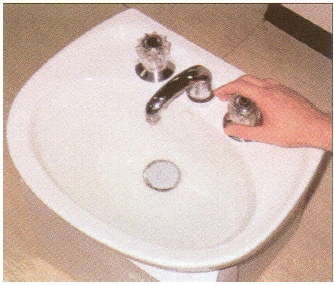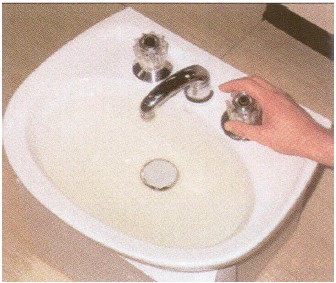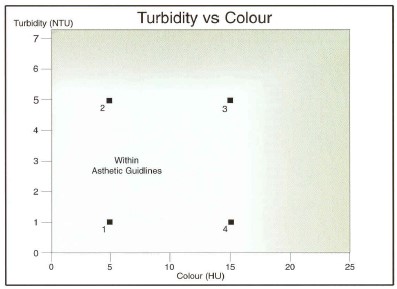Colour (True)
(endorsed 1996)
Guideline
Based on aesthetic considerations, true colour in drinking water should not exceed 15 HU.
General description
Two terms are used to describe colour. ‘True colour’ is the colour after particulate matter has been removed (usually by filtration through a 0.45 micrometer pore size filter). ‘Apparent colour’ is what one actually sees; it is the colour resulting from the combined effect of true colour and any particulate matter, or turbidity. In turbid waters, the true colour is substantially less than the apparent colour.
In natural waters, colour is due mainly to the presence of dissolved organic matter including humic and fulvic acids, which originate from soil and decaying vegetable matter. Surface water can also be coloured by waste discharges, for example from dyeing operations in the textile industry, and paper manufacture.
The dissolution of metals in pipes and fittings can also discolour drinking water. Badly corroded iron pipes can produce a brownish colour whereas corrosion of copper pipes can produce a blue-green colouration on sanitary ware and a faint blue colour in water in extreme cases. The condition of household pipes can significantly influence water colour.
In bore water, ‘red water’ is a frequent problem, caused by the oxidation of iron. In addition, a black discolouration in reservoirs and distribution systems can result from the action of bacteria on dissolved manganese to produce insoluble oxides. Some of these compounds form fine suspensions, or are only partially dissolved, and so contribute to apparent rather than true colour. (See Section 5.6 Nuisance organisms).
As a guide, tea has a colour of about 2500 Hazen units (HU, see below). A true colour of 15 HU can be detected in a glass of water, and a true colour of 5 HU can be seen in larger volumes of water, for instance in a white bath. Few people can detect a true colour level of 3 HU, and a true colour of up to 25 HU would probably be accepted by most people provided the turbidity was low. Some examples of drinking water with differing turbidity and colour are shown in Plate 1.
True colour is preferred analytically, as the measurement is more precise than for apparent colour, and not as dependent on site or time. If both true colour and turbidity are at the guideline values (i.e. true colour of 15 HU and turbidity of 5 NTU[Nephelometric Turbidity Units]), the apparent colour could be 20 HU. This is considered to be acceptable.
Variations in colour are likely to lead to more complaints than a high but consistent colour.
Typical values in Australian drinking water
In major Australian reticulated supplies true colour ranges from 1 HU to 25 HU for filtered or fully treated supplies, and from 1 HU to 85 HU for unfiltered supplies.
Measurement
Colour can be measured spectrophotometrically or using a visual comparator. In both cases, the standard unit of measurement is the Hazen unit (HU). (True colour is often quoted as True Colour Units, or TCU; however, the numerical values are identical.) Hazen units are defined in terms of a platinum–cobalt standard (APHA Method 2120B 1992). This standard was developed for the analysis of colour in natural waters with a yellow-brown appearance, and is not applicable to waters with different colours.
It is advisable to record the pH with the colour measurement, as the colour of natural surface waters increases with pH.
Colour values obtained using a spectrophotometer are dependent on the wavelength used for the measurement. There is no standard wavelength used in Australia, but values ranging from 395 nm to 465 nm are generally used. In the absence of a suitable Australian Standard, the British Standard, which uses 436 nm (BSI Method BS6068 1986), is suitable.
Treatment of drinking water
Constituents of natural colour derived from humic and fulvic acids can be reduced by coagulation followed by filtration (AWWA 1990). Oxidation by chlorine or ozone will also reduce colour but may produce undesirable by-products.
Health considerations
Colour is generally related to organic content, and while colour derived from natural sources such as humic and fulvic acids is not a health consideration, chlorination of such water can produce a variety of chlorinated organic compounds as by-products (see Section 6.3.2 on disinfection by-products). If the colour is high at the time of disinfection, then the water should be checked for disinfection by-products. It should be noted, however, that low colour at the time of disinfection does not necessarily mean that the concentration of disinfection by-products will be low.
Reactions between naturally occurring humic and fulvic material and water disinfectants (such as chlorine, ozone, chloramines and chlorine dioxide) can also cause difficulties in maintaining an adequate level of disinfectant, thus creating the opportunity for bacterial reinfection or regrowth.
The solubility of some organic pollutants can also be increased through complex formation with humic material.
Coloured water may prompt people to seek other, perhaps less safe, sources of drinking water.
Derivation of guideline
The guideline value is based on the colour that is just noticeable in a glass of water. This is generally accepted as being 15 HU.
Guidelines in other countries
The Canadian Guidelines and the 1984 World Health Organization (WHO) Guidelines both recommend a value of 15 HU. The 1993 WHO Guidelines indicate that a colour above 15 TCU may give rise to consumer complaints.
The United States EPA Secondary Drinking water Regulations have a maximum concentration for colour of 15 HU.
The European Economic Community Standards for colour are a maximum admissible value of 20 HU and a guideline value of 1 HU.
References
APHA Method 2120B (1992). Colour: Visual comparison method. Standard Methods for the Examination of Water and Wastewater, 18th edition. American Public Health Association, Washington.
AWWA (American Water Works Association) (1990). Water Quality and Treatment: A handbook of community water supplies. AWWA, 4th edition, McGraw-Hill Inc.
BSI Method BS6068 (1986). Examination and determination of colour. British Standards Institution, British Standard for Water Quality, Section 2.22.
WHO (World Health Organization) (2006). Guidelines for Drinking-water Quality. 3rd Edition, WHO, Geneva, Switzerland.
Colour and Turbidity
1. Colour = 5 HU Turbidity = 1 NTU

2. Colour = 5 HU Turbidity = 5 NTU

3. Colour = 15 HU Turbidity = 5 NTU

4. Colour = 15 HU Turbidity = 1 NTU

